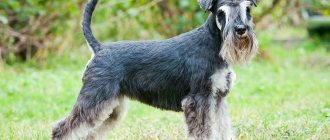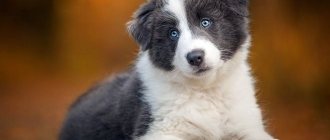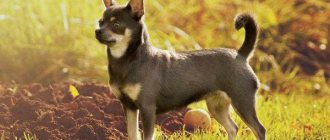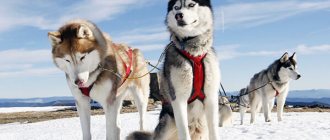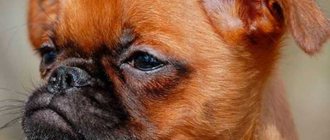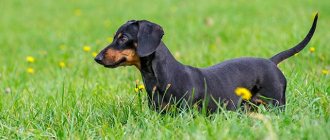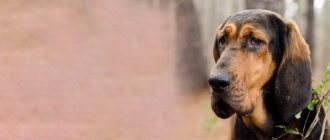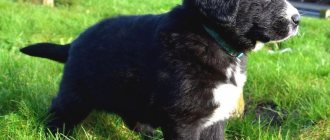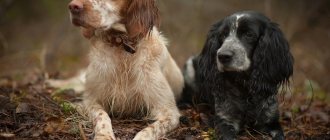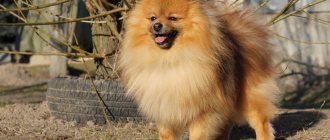Description of the Miniature Schnauzer breed
Popularity 90th place among 263 dog breeds
Lifespan:
12-15 years
Breed group:
Service
Height:
30-35 cm
Country of origin:
Germany
Average price:
25-35 thousand rubles
Weight:
4-8 kg
Latest articles Cat health
Rabies vaccination for cats: choice of vaccine, necessity, schedule 01/22/2022 23 0 0
Selection and adaptation
TOP 20 best cat breeds for families with children 01/22/2022 37 0 0
Key facts
The Miniature Schnauzer translates from German as “barbel gnome,” or “whiskered face,” and the dog lives up to its name, being the smallest working breed in the world.
As a service dog, miniatures are used mainly by drug and explosives departments, in which the dogs are helped by their outstanding sense of smell and excellent intuition. The description of the Miniature Schnauzer breed states that the dogs, in addition to their service qualities, have well-developed hunting and guarding skills.
The miniature himself, despite his miniature size, is ready to loyally protect his family with all the seriousness of a large service dog. Or herd sheep - he can do that too.
The Miniature Schnauzer is an excellent companion, he loves children and will be a wonderful play partner for them. They are suitable for both apartment living and living in your own home.
Miniature Schnauzers are very active dogs and show good results in sports. The characteristics of the Miniature Schnauzer breed add to this that the dog requires a good walk.
Like any dog, especially a service dog, a miniature dog must be trained, socialized and educated.
Miniature Schnauzers are very healthy dogs; usually, diseases begin to appear only in old age. The life expectancy of a miniature schnauzer is very high. But in terms of care, this breed is quite labor-intensive. If you want to see your pet beautiful, you will have to regularly cut it, trim it or contact a professional groomer, especially if you have a show dog.
Miniatures have only four generally recognized colors: black, pepper and salt, black and silver and white. In some countries, dogs of unrecognized colors are bred.
The breed is one of the ten most popular in the world because of its easy-going, cheerful character even in old age, its willingness to keep company and take part in any adventures of its owner.
Combing
The length of the miniature's coat is controlled by cutting with a special clipper . Usually the owners cut the fur, leaving a soft undercoat.
But for those who raise a show dog, it is necessary to take into account one more nuance, namely trimming during molting, that is, plucking out dead hairs.
If this procedure is carried out regularly, then there will never be wool lying around in the apartment. You can comb the animal with a furminator .
The surface of the head, ears, abdomen and neck is treated with special scissors to avoid pain.
The Miniature Schnauzer needs daily brushing, and for such grooming you do not need to go to a specialist.
From time to time it is necessary to bathe with high-quality professional shampoos and conditioners.
The Miniature Schnauzer's beard requires special attention.
It is necessary to carefully wipe it with napkins every time after eating to remove moisture and food residues.
The Miniature Schnauzer loves walks in the fresh air and active games. He will be happy to join you in playing frisbee and chasing the ball
History of the origin of the miniature schnauzer
The breed originated in Southern Germany. These dogs were used on the continent for the same purposes for which terriers were used in Great Britain - for home guarding and hunting rodents. Presumably, at that time they were pinschers, smooth-haired and wire-haired. In the middle of the 19th century, wire-haired dogs began to be separated into a separate branch. At that time there was no division into miniature, miniature and giant schnauzers; wire-haired individuals of all sizes were simply called rattlers, and later - schnauzers.
The record of the first schnauzer dates back to 1888. At an exhibition called “Wirehaired Pinscher”, it was first presented a year later by a male named “Schnauzer”, from where the breed took its name. Josef Bertha, chairman and founder of the Pinscher Club in 1895 in Saxony, made a great contribution to the development of miniatures. He began breeding work on breeding dwarf schnauzers and worked closely with the Saxon nursery Chemnitz-Plauen.
The goal was to breed a small companion who could live in small apartments and at the same time have all the working and personal qualities of a Schnauzer. The theory about the selection of the smallest schnauzer puppies for breeding miniatures has not been confirmed - most likely, the blood of Affenpinschers, poodles, and Spitzes was used to produce a miniature schnauzer. Sometimes these impurities produced undesirable colors, and multi-colored and white puppies were excluded from breeding.
Despite this, there is still a rich variety of unrecognized colors among miniatures. In 1902, 14 representatives of the breed were already registered in the stud book of the Pincher Schnauzer Club.
In the first half of the 20th century, schnauzers spread throughout the world. They came to the USSR only in 1974: these were three dogs imported by Grossman from the USA, but the main stock originates from service Czechoslovakian miniature dogs, donated by Czechoslovak servicemen to their colleagues in Lvov. From there, the little schnauzers came to Moscow with the permission of the USSR Ministry of Internal Affairs. These bloodlines can still be traced in many representatives of the breed. The National Breed Club (NKB) was created in Russia in 1994.
Dog health
Cataracts cause the lens of the eye to become opaque, resulting in poor vision. The dog will have blurred vision. Cataracts usually occur in old age and can sometimes be removed by surgery to improve vision.
Progressive retinal atrophy is a group of eye diseases that involves the gradual deterioration of the retina. At the onset of the disease, affected dogs become blind. They lose vision gradually as the disease progresses. Many affected dogs adapt well to their limited or lost vision as long as their environment remains the same.
Stone disease may cause your Miniature Schnauzer to strain to urinate, may have blood in its urine, may urinate more often than usual, and have dirty and foul-smelling urine. While small stones may pass on their own, do not delay in visiting a professional. Dietary changes are not guaranteed to get rid of existing stones, but they may prevent more stones from forming.
Miniature Schnauzers are healthy, but like all breeds, they are susceptible to certain diseases. Therefore, it is important to know all possible diseases and rules for caring for a dog. And then the Miniature Schnauzer will become a wonderful addition to an active family.
Appearance of miniature schnauzers
General impression
The Miniature Schnauzer is a smaller copy of the Miniature Schnauzer without signs of dwarfism. This is a small, strong dog with a square body, cheerful and temperamental, with a stable psyche.
Head
The head is strong, slightly elongated, harmonious in relation to the body. There is practically no occipital protuberance, the bridge of the nose is straight and flat. There are no folds on the forehead. The transition from the forehead to the muzzle is quite pronounced and emphasized by shaggy eyebrows. The muzzle is wedge-shaped, blunt, ending in a black, well-defined nose.
Powerfully developed jaws are covered with tightly fitting lips. The dental formula is complete, white large teeth are closed in a scissor bite. The nodules are developed but do not change the shape of the muzzle.
The eyes are oval, dark brown, look with lively interest, the eyelids are not heavy and do not droop. The ears are set high, hanging behind the break line, have a triangular uniform shape and touch the edges of the cheeks.
Neck
The neck corresponds to the image of a dog: strong, with a clear scruff, smoothly ending at the withers. The skin fits tightly, there are no folds.
Torso
The body is square in shape, the line of the back is higher at the withers and smoothly descends to the croup. The back itself is strong with a short but deep loin, giving the dog a square shape. The chest is well developed, moderately wide, and when viewed in profile reaches the elbows. The belly is tucked up and forms a single bottom line.
Tail
The tail is saber-shaped or sickle-shaped, set high. It can stop in non-show dogs in the area of the third joint.
Forelegs
The forelimbs are strong with good angulations and pronounced shoulders. The elbows are pressed tightly to the body, the limbs themselves are parallel, not turned out. The paws are round, cat-like, with tightly knit toes.
Hind limbs
The hindquarters are well-muscled, sloping at the sides and parallel at the rear, with clear, good angulations, short metatarsals, perpendicular to the surface.
Movements
The movements are sweeping, elegant, well coordinated, with a strong reach of the front legs and an equally strong push from the hind legs.
Wool
The miniature's coat should be thick and hard, like wire, with a thick undercoat and a long, straight spine. Its toughness is noticeable even in the photo of a miniature schnauzer. American dogs have much softer fur than European dogs. Thick eyebrows and beard are clearly visible.
Color
Until 1976, there were two canonical colors of the miniature schnauzer - pure black, without a brown tint, and pepper and salt. In 1977, black and silver was recognized. The white color has had a long and thorny path - more than 35 years passed from the first white puppies to the recognition of the color in 1983.
White miniature schnauzers, contrary to popular belief, are not albino - they are a recessive red color produced by pepper-and-salt dogs. For a long time, chocolate and tan miniatures were bred; this color was especially popular in Russia, but in 2010, after a statement by the Pincher Schnauzer Club, this color was closed by the FCI, and after it in 2011 by the RKF, as not meeting the standard, t .To. Dogs of this color have a brown nose, lips, and light brown or green eyes.
Many enthusiasts in Russia are still breeding them outside the RKF system. Also in different countries, mainly in the USA, miniature dogs of exotic colors are bred as designer dogs. These include liver, chocolate, baked milk, red agouti, blue and liver merle, and just a variety of spotted colors.
Size
The dimensions of the miniature schnauzer are the same for males and females; they range from 30-35 cm in height and 4-8 kg in weight. The growth of a miniature schnauzer should not be too great, since miniature schnauzers already begin to grow beyond the limits.
The Miniature Schnauzer's weight does not need much control: thanks to its mobility, the dog is not prone to obesity. Despite the size of miniature schnauzers, dogs cannot be classified as decorative dogs - they are smart and brave animals with a big heart.
Possible disadvantages
In the description of a miniature schnauzer, the following are considered non-compliances with the standard:
- Round and massive skull;
- Folds on the body;
- Muzzle that is too short or excessively pointed and elongated;
- Elongated, curved back;
- Long, soft, wavy coat;
- Imperfect bite, yellow and sparse teeth, presence of caries;
The presence of pathological nervousness, suspicion, uncertainty and timidity, as well as excessive aggression.
Character of the miniature schnauzer
The character of the Miniature Schnauzer was inherited from its ancestor, the Miniature Schnauzer. A brave heart beats in a small miniature. Representatives of this breed are temperamental, vigilant, have a stable psyche and excellent watchdog qualities. Already a small puppy is ready to selflessly defend his home and family from strangers. Adult dogs very clearly distinguish between friends and strangers and are wary of strangers.
Miniature Schnauzers love children. Children for them are the best companions for games and pranks, in which miniatures are tireless. They get along well with other animals. The exception is the historical prey of miniature schnauzers - small rodents, which it hunts no worse than cats. If you have a miniature mouse in a house with mice, the latter will quickly disappear.
Miniatures are kept at home, even if they live in a country house. They are not suitable for outdoor use. Miniatures will feel great in an apartment.
Who is this breed suitable for? The zverg is a wonderful pet and is suitable for almost everyone: a single man, a noisy large family, and cheerful, active old people. You should not get a miniature dog if you are a homebody or a workaholic who disappears at work, or if you think that a small dog does not need training and education.
Miniature Schnauzers are charming in their cunning: they are rare sneakers who, at the same time, are wholeheartedly devoted to their owner and are ready to give their lives for him.
Psychology
Like other breeds of the family, including the Miniature Schnauzer , the Miniature Schnauzer is very active and alert. This dog obeys commands very easily.
He is not very friendly towards strangers, but he is intelligent and is always ready to remain useful.
He does not show excessive aggression, but he is not timid either. This trait is reminiscent of the Leonberger dog breed.
Distrustful of strangers, always cautious.
Like other schnauzers, the Miniature Schnauzer is very active and alert. This dog obeys commands very easily
The Miniature Schnauzer can be called a big dog contained in a small body.
The Miniature Schnauzer dog is wary of everything that surrounds it, and, like the Kuvasz or Groenendael , has a great desire to protect its owner.
These cute dogs love to bark, which makes them good watchdogs.
The Miniature Schnauzer is chosen by those who need a companion or just a family pet. Since the dog requires constant attention, families where there is always not enough time are not suitable for him. They are good friends for children, loving family, they bring a lot of joy to the home
Education and training
Due to their nature, miniature schnauzers require full training, and training a dog should begin from the moment it appears in the house. The owner must become an authority for the puppy, otherwise achieving obedience will not be easy.
How to stop your baby from biting and chewing things? The most effective way is to take advantage of the breed’s temperament and playfully switch the puppy’s attention to balls, squeakers and toys. Miniatures are by nature more playful, so during training, games, praise and a favorite object will be an excellent reward for a correctly completed exercise.
Miniature Schnauzers are easy to train, intelligent and always ready to work. Exercises for miniatures should not be monotonous and monotonous. Despite their excellent working qualities, this breed is much easier to train through play.
Representatives of this breed have excellent visual memory, so it is imperative to reinforce voice commands with gestures. Thanks to this feature, miniatures successfully participate in agility, freestyle, and easily learn and show circus tricks.
Taking into account all the character traits of these dogs, you will become the owner of a well-mannered and trained miniature dog without much effort.
Key points in training
Miniatures can be willful, but they are easy to break if you show leadership qualities, but this does not mean that the dog should be abused. Rough methods are prohibited. Enough with a stern look, a light pat on the back or rump, ignoring or depriving him of treats.
Schnauzers love equal treatment, so you need to negotiate with your pet. The owner must be strict and adamant; he must ensure strict execution of the command. Otherwise, Zverg will feel weak and “sit on his neck.” These pets can dominate.
The animal needs to understand the hierarchy in the family and learn the rules of behavior. He is not allowed to beg, chew furniture, or lie on the master's bed. They are trained from early childhood, when the dog cannot yet be cunning and evade.
The pet must listen to the owner’s voice under any conditions, understand his commands, and respond quickly to them.
Active workouts of 15-20 minutes will be the best. The dog needs to be interested in games, treats and toys. This breed is easy to train. Schnauzers can even be circus dogs; they can perform any tricks. With these dogs you can sign up for any training course at the club; they need to learn to control mistrust and aggression, and properly guard property.
Read about how to properly train a dog in the article: “Training a puppy: effective methods from dog handlers, learning commands at home.”
Miniature Schnauzer Health and Diseases
Possible diseases
Miniature Schnauzers are healthy dogs that are practically not prone to diseases. The most common ailments of miniatures:
- Eye diseases mainly manifest themselves as glaucoma and cataracts only in advanced age. The exception is chocolate-tan dogs: due to their genetic characteristics, eye diseases can manifest themselves at a fairly young age, which is why dogs of this color were removed from official breeding.
- Allergies and skin diseases. Traditionally, white dogs are more prone to them. The main treatment for allergies is identifying and eliminating the allergen. Skin inflammation may be accompanied by scratching and hair loss. You should pay special attention to your dog after a haircut, as using a clipper often causes irritation.
- Neoplasms of various etiologies also occur mainly in older dogs.
- Various stomach disorders. Miniatures have a rather delicate gastrointestinal tract, so changing food or type of food should be gradual.
To avoid infectious diseases, the puppy should receive preventive vaccinations up to a year, and subsequent vaccinations should be carried out in a timely manner. Miniature dogs are not prone to obesity, but nevertheless, the dog must receive adequate nutrition and exercise.
Reproductive health
Bitches come into estrus at intervals of 6-8 months. You can breed a bitch no earlier than 15 months and her second heat. Males are untied no earlier than a year. You cannot breed miniatures without a pedigree, different colors, or with defects. You should not be guided by considerations about mating for the sake of “the happiness of motherhood” or “for health”; in these cases, sterilizing the dog would be a reasonable solution.
It is also difficult to make money from breeding - although the price of puppies with a pedigree is quite high, but for mating, childbirth, complementary feeding, paperwork, branding of offspring, vaccinations, enhanced nutrition and vitamins, you will pay approximately the same amount as you get for the puppies.
Before mating, it is better to introduce the bitch to the male. It is imperative to make sure that both partners are healthy, since healthy puppies are born to healthy parents. You can breed dogs of the same color, but the male should not be much larger than the female. Estrus lasts about 20 days, based on this, the main and control matings are carried out on days 10-14 with an interval of a day.
Pregnancy lasts on average 58-64 days. In the first half of pregnancy, the bitch’s lifestyle and diet practically does not change, and starting from the second half, the number of feedings is gradually increased to 4-5 and vitamins are added. Some breeders recommend giving the bitch mineral water or calcium supplements.
Miniature Schnauzers usually give birth on their own without any problems, the average number of puppies is 4-5, but up to 9 can be born. The owner is assigned the role of an attentive observer. It is imperative to have a veterinarian who will come on call in case of complications.
How much does it cost and where to buy
The National Breed Club (NKP) is a Miniature Schnauzer club registered in Russia, engaged in breeding work, exhibition activities, and popularization of the breed.
More than 20 kennels in Moscow, St. Petersburg, Ufa, Rostov-on-Don, Vyborg, Kaliningrad, and Nizhny Novgorod are engaged in breeding and selling dogs in Russia.
The price of puppies varies:
- elite puppies from the nursery from parents of exhibition winners - from 30,000 rubles ;
- puppies with a pedigree that fully comply with the standard 15,000 - 30,000 rubles ;
- puppies with defects, with a note in the pedigree “not for breeding” and puppies without documents - from 10,000 rubles .
Features of feeding and diet
Puppies are given away at an age when they are already feeding themselves, so the breeder will tell you how to feed and what to feed the babies at first. You can’t change food suddenly, so if you want to change food or switch your dog from dry to natural or vice versa, do it gradually.
How many times should puppies be fed? At the age of 2-3 weeks, puppies begin to be offered complementary foods. A one-month-old puppy already eats solid food 6 times a day, but the share of mother’s milk is still large, so babies are sent to new families no earlier than 1.5-2 months. At this age, puppies receive four meals a day. As they grow, starting from 4 months, puppies are transferred to three meals a day, and by 8 months the dog can be fed twice a day.
What food to feed is up to the owners to decide. Complete dry food has the advantage of being balanced and easy to feed - just pour in the right amount of granules, and that’s all there is to cooking. It is worth choosing a good food, the ingredients of which will have a meat component in the first place. The food should be suitable for your pet's age, size and activity.
The indisputable advantage of natural food is its taste. If you put a bowl of dry food and a bowl of boiled beef in front of your dog, it is obvious that the dog will choose meat. But natural nutrition requires variety, supplementation with vitamin complexes and free time.
What should you not feed your dog?
- sweets and baked goods;
- spicy, smoked, fried foods;
- river fish;
- bones.
The animal should be able to drink at any time, this is especially true for drying dogs. Therefore, keep a bowl of clean water in an open place.
Food
Meals should be four times a day for up to four months, three times a day for six months, and two meals a day after eight months. The diet should not contain sweet, smoked or spicy foods. You cannot feed a dog from the table - the miniature can make a pitiful look, but this is just a cunning attempt to manipulate the owners.
- If you take ready-made food, then the best is premium and super-premium especially for small dogs.
- Natural products are also needed, but they should not be mixed with food. The diet should be based on meat, offal and cereals.
It is important to have boiled sea fish, fermented milk products (low-fat), yolk, and seasonal fruits.
Care and maintenance
The Miniature Schnauzer's coat requires a lot of care to keep your pet looking neat. A puppy should be taught to brush from an early age, and this should be done immediately on the table, since in the future all grooming procedures will be carried out on it. The miniature dog does not require frequent washing, but you need to regularly wash its paws after walks and its beard after eating.
The miniature dog needs to be trimmed and the feathers on its paws, eyebrows and beard trimmed once every 2-3 months. It is better to entrust this procedure to a professional groomer. Trimming can be done by hand or with a trimmer; a trimmer is not used on the head. This is a rather lengthy and labor-intensive procedure, which takes 2-3 hours for regularly trimmed dogs, and up to 5 for neglected individuals.
After trimming, a miniature dog's skin is especially delicate, and in the cold season it is better to insulate the dog while walking. It is also better to entrust preparations for an exhibition to professionals, since cutting and grooming dogs of different colors has its own nuances.
Miniature Schnauzers are quite active; they require long walks 2-3 times a day. It’s good if the dog plays sports with its owner.
The main points of care and maintenance of miniature schnauzers are constant coat care and active walks. Everything else is quite simple and not troublesome.
Possible diseases
Miniatures have excellent health, but still some troubles should be anticipated.
- Eye disease is most likely to occur, usually in aging dogs. Therefore, it is worth regularly wiping your eyes, removing secretions and preventing the formation of crusts.
- There are known cases of allergic reactions to a sudden change in diet or an unsuitable product. The irritant should definitely be identified, and changes in diet should be made gradually.
- Inflammations on the skin may also appear, in particular after trimming.
In any case, if your pet has become even a little lethargic or refuses to go for a walk, this is a reason to immediately contact a veterinarian.
Tips for choosing a puppy
It is better to buy a puppy from a nursery, because a pedigree is not just a piece of paper for exhibitions, but a document that guarantees the purebred of the dog and reduces the likelihood of mental and behavioral defects and genetic diseases. In the nursery you can get advice on the care, feeding and maintenance of the puppy, communication with the breeder throughout the dog’s life, contacts of trusted groomers and veterinarians; look at the puppy’s parents, and the baby himself will be vaccinated and free of worms, fleas and terrible intestinal infections.
First of all, you should pay attention to the condition of the mother and the maintenance of the miniature schnauzer puppies - if the bitch is thin and emaciated, or the seller finds it difficult to show her, and the puppies are crawling in a dirty enclosure, are passive, and look unkempt - run away from there.
Your puppy is clean, active, well-built, with lively eyes and clean ears. He may be wary, but not aggressive. What gender your future pet will be is only your choice.
Application
Most often, those who need a companion or just a family pet decide to buy a miniature schnauzer puppy.
Since he, like the Pomeranian and German Spitz , requires constant attention, families where there is always not enough time are not suitable for him.
Good friends for children, loving family, they give a lot of joy.
Miniature Schnauzer respects the classics
